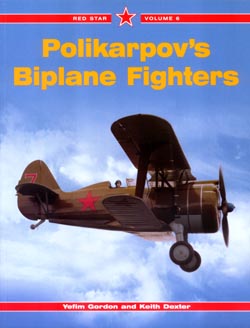 Polikarpov’s Biplane Fighters Polikarpov’s Biplane Fighters
Red Star Volume 6
By Yefim Gordon and Keith Dexter
Midland Publishing, 2002
ISBN 1-85780-141-5
Softbound, 128 Pages
Available from Specialty Press for $27.95 When one thinks of Polikarpov, thoughts turn to the I-16 and perhaps the last of the biplane line, the I-153, but there was a long line of fighters before those two, dating all the way back to the early 1920s. This book sheds some light on the entire line of Polikarpov biplane fighters, starting with the 2I-N1 two seat fighter from 1924 and finishing up with the I-195 from 1940. In between these two types are a great number of designs that pushed the envelope of biplane design and placed Polikarpov’s name firmly in the forefront of VVS fighter technology. By 1940, there were more Polikarpov aircraft built than all the other Soviet aircraft manufacturers combined, and by the start of the Second World War in 1939, over 90% of the fighters in Soviet service were Polikarpov designs, many of which were biplanes. Like other titles in the Red Star series, this book does not merely focus on those aircraft that entered frontline service, but rather takes a close look at the entire progression of biplane design of Polikarpov. The development into one of the best biplane fighters took time and experimentation, and this book covers many of the steps along the way. The first 2I-N1 and I-3 were streamlined aircraft that were attractive and completely unlike what is traditionally thought of as a Polikarpov biplane. Using inline engines, these early designs were straightforward, and this book provides what is probably the first glimpse for many readers as to what these planes looked like. While the 2I-N1 did not progress past its single prototype, the I-3 was more successful and the operational history is included in the text. The association of Polikarpov and radial engines started with the I-5 design, and it was here that Polikarpov’s design prowess began to shine. Interestingly, though, because Polikarpov failed to meet the deadlines for both the I-5 and I-6 prototypes, he was jailed for industrial espionage, an inauspicious beginning for a great designer, and would ultimately cast a shadow of doubt on all his future designs. The development and operational history of the I-5 is covered in detail, along with the various modified airframes and developmental steps that led to the first gull-wing design, the I-15 Chato. With the I-15, the book enters into the era of wartime Polikarpov biplanes, and expectedly there is more coverage on the operations of these types, both in Spain and in the Soviet Union. There are also more photos of these later types as well, although all of the types are well covered in pictures. In addition to the standard I-15, all of the test aircraft such as the I-15V pressurized example are covered. The return to traditional biplane design in the I-15bis is also well covered, both in text and in photos. The return to the gull wing design in the I-153 marks the end of the operational biplane fighters of Polikarpov, and like the other sections it is amply covered. There are plenty of detail photos of the I-153 present throughout this section, and the operational history is fascinating, starting with operations in Mongolia and continuing on to the Winter War with Finland and even Chinese service. Several units still operated the I-153 when Germany invaded in 1941, and their operations are also covered, both for the Soviet Air Force and the Naval Air Arm. The final pages of the I-153 section deal with many of the project airframes, including a high-altitude fighter equipped with a turbo-supercharger. The remainder of the book covers the swan song of the Polikarpov biplane fighter line, with test aircraft such as the I-170, I-190, and I-195. None of these went past the prototype stage, and the I-170 and I-195 never left the drawing board. Monoplanes had superceded biplane designs by this time, and Polikarpov went on with the I-16, I-180 and I-185. Following this short section on the last examples of biplane fighters is a section of scale drawings, followed by color profiles covering the entire range of aircraft. This is a great reference for the Polikarpov biplane family and sheds light on aircraft that have not been covered much. The fascinating history of Polikarpov is told well in this volume and makes for a great companion piece to Red Star Volume 3 on the Polikarpov I-16. Between these two books is the most comprehensive history of Polikarpov and make an essential part of any Soviet aviation library. This book is available from Specialty Press for $27.95. Other Red Star titles are also available, including the I-16 volume.
| 









|
 Polikarpov’s Biplane Fighters
Polikarpov’s Biplane Fighters 








